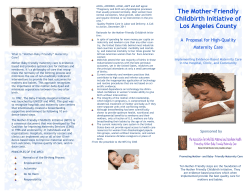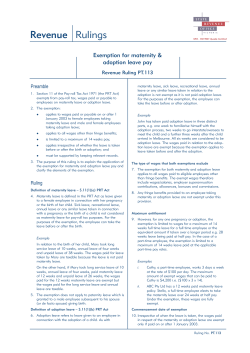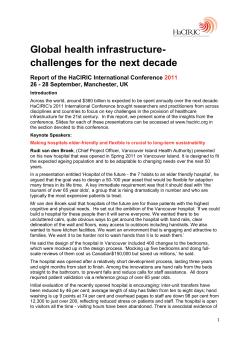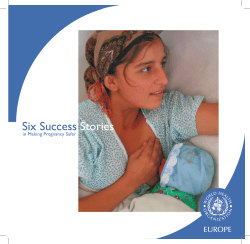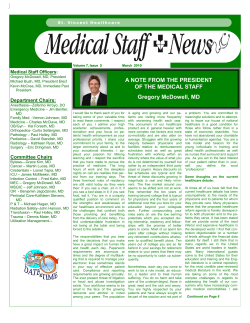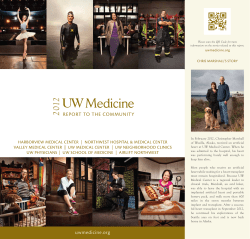
Family Centered Maternity Care Position ICEA Position Paper
ICEA Position Paper Family Centered Maternity Care Position lines for family-centered care in 2000 (PHAC, 2000). In response to the Institute of Medicine’s publication of “Crossing the Quality Chasm”, many professional organizations have published statements on “family-centered care” or “patient-centered care” (AWHONN, 2012; AAP, 2012). The International Childbirth Education Association (ICEA) maintains that familycentered maternity care is the foundation on which normal physiologic maternity care resides. Further, family-centered maternity care may be carried out in any birth setting: home birth, birth center birth, hospital birth or emergent birth. In short, family-centered maternity care respects the family as a unit, the mind-body-spirit of the family, and provides evidence-based care accordingly. Definitions of patient-centered care, family-centered care, and FCMC differ between various disciplines. In spite of this, there are common themes these publications share: Birth is a normal, healthy process for most women; Care must be individualized; Decision-making should be a collaborative effort between the pregnant woman and her healthcare providers; Education should reflect current, evidence-based knowledge; Introduction Information should be shared freely between the pregnant woman and each of her healthcare providers; and Family-centered maternity care (FCMC) has been a hallmark of ICEA since its inception in 1960. At that time, “family-centered” meant including the father in childbirth preparation classes and in the birth itself. Over time, even as family members were welcomed in the birthing room, technology played an increasingly significant role in the birth experience. In response to this, Celeste Phillips wrote the textbook entitled “Family-Centered Maternity Care” (Phillips, 2003) in the mid 1970’s. A decade later, McMaster University published a definition of FCMC that was then adopted by ICEA. (ICEA, n.d.) In 1996, the Coalition for Maternity Services published the Mother Friendly Childbirth Initiative which was endorsed by many professional and consumer organizations. (CIMS, 1996) The Public Health Agency of Canada released its national guide- Mothers and babies should stay together (rooming in). In addition to these common themes, the following principles are also endorsed by one or more of these organizations: The presence of supportive people during labor and birth is beneficial to the mother and family; Mothers are the preferred care providers for their children; Freedom of movement is beneficial for the laboring woman and should be encouraged; continued on next page 1 Routine interventions that are unsupported by scientific evidence should be avoided; As is mentioned in many of the position papers previously cited, respect should extend to each member of the healthcare team. The goal is to provide quality care for mother and baby. This requires the cooperation of all involved – nurse, doula, midwife, physician, lactation consultant, and any others that the woman may look to for help and advice. All members of the healthcare team should be educated about physiologic birth and non-pharmacologic methods of pain management; and Skin-to-skin contact immediately after birth and exclusive breastfeeding should be standards of practice. Openness These organizations have provided a necessary framework of protocols for the delivery of healthcare, but what that care means to the family is only occasionally alluded to. MacKean (2005) suggests that healthcare providers, acting in the role as an expert in their field, not only define family-centered care, but also define the parents’ role in it. By doing so, they subtly undermine the desired collaborative relationship between providers and parents (MacKean, Thurston, & Scott, 2005). As professionals, they have made a decision for the parents. So the question must be asked: what does FCMC mean to the family? What is the goal of family-centered care as it pertains to the families themselves? Open communication is necessary to provide the highest quality care. Each member of the circle of care is responsible for their own part in this. The pregnant woman and her family should be honest about their desires and beliefs, communicating clearly and early in the pregnancy to minimize the risk of misunderstandings. Healthcare providers should communicate just as clearly, not only with the parents but with others involved in their care. Collaboration cannot be effective if communication is hindered in any way. Relational competency is also necessary to FCMC. This extends beyond simple communication to include sensitivity and compassion (MacKean, Thurston, & Scott, 2005). Communicating facts without sensitivity is not characteristic of the openness that defines FCMC. Respect Mutual respect is foundational to FCMC – respect for pregnancy as a normal, healthy event in a woman’s life, respect for parents as the primary caregivers for their children, respect for each member of the circle of care. Confidence When pregnancy is acknowledged as a healthy life event rather than a condition that must be treated, intervention will be minimal. This attitude will convey support and encouragement to the pregnant woman and her family as opposed to the fear and stress that is so often experienced in an illness-oriented environment. Imbuing the woman and her family with confidence is central to quality family-centered care. Excellence in the technical, medical aspects of care is expected, but not adequate, in and of itself. Birth is more than just the mechanical event of moving the baby from the inside to the outside. It is one of the most significant developmental stages of life – emotionally and socially (Zwelling & Phillips, 2001; Jiminez, Klein, Hivon, & Mason, 2010). Parents are the primary caregivers of their children (AAP, 2012; MacKean, et al., 2005). This starts even before birth. Women decide when – and even if – they will start prenatal care. They choose whether or not to modify their diet and other aspects of their lifestyle. This autonomy should continue throughout pregnancy, during labor and birth, and through the postpartum period. A goal of FCMC is to build the confidence of new parents. Supporting and encouraging new parents as they care for their infant builds trust in their own abilities (Karl, Beal, O’Hare, & Rissmiller, 2006). When professionals perform tasks parents can do on their own, they undermine the parents’ sense of competence. FCMC that is truly family-centered supports parents continued on next page 2 as they care for their newborn. In the case of high-risk infants, parents should participate as much as possible in the infant’s care including, but not limited to, the decision-making process, kangaroo care, and breastfeeding. logic forms of pain relief, breastfeeding support, and perinatal mood disorders. Cultural preferences of the mother should be honored. All medical staff should support the role of the mother as the infant’s primary care provider. Facilities will also provide evidence-based education for the mother and her family. In addition to specific classes for childbirth and breastfeeding, education should also be part of each prenatal and postpartum visit. Information about support groups for breastfeeding, perinatal mood disorders and early childhood parenting should be readily available. Knowledge Knowledge is necessary for women to be wise decision-makers. Part of prenatal care should include educating the woman about pregnancy, birth, and postpartum – making sure she is aware of evidence-based research and all options available to her. Outcomes Knowledge is necessary in order for healthcare providers to provide quality care. Effort must be made to incorporate evidence-based research into current practice. This will not happen if those providing care are not aware of what the research says. FCMC results in greater satisfaction for all involved. Families that are cared for with a family-centered model will experience greater satisfaction with their birth experience. They will have participated in the decision-making process which will increase their self-confidence. They will have validated their learning with real life experience. Healthcare providers that work within a family-centered model will also experience greater satisfaction (AAP, 2012). Atmosphere In an atmosphere of FCMC, women will: 1.Choose the caregiver and place of birth that is most beneficial for her; Implications for Practice 2.Work in collaboration with healthcare providers and other advisers that she chooses; FCMC recognizes the significant transitions that occur during the childbearing year. Physical changes are obvious. Social and emotional adaptations are no less important. Care that is truly family-centered is safe – physically and emotionally. Medical expertise should be accompanied by compassionate and skillful communication. Collaborative decision-making should proceed out of relationships built on mutual respect. Both parents and professionals should have access to the latest evidence-based research. 3.Have the support people she desires present whenever she wishes;; 4.Move around and use whatever position she feels is beneficial during labor; 5.Refuse routine procedures that are not evidence-based; 6.Practice uninterrupted skin-to-skin contact and breastfeeding immediately after birth, keeping her baby with her at all times (rooming in); and Many healthcare and governmental agencies have established various protocols to promote family-centered care. These are necessary and helpful. But as ICEA has always stated, “FCMC consists of an attitude rather than a protocol” (ICEA, n.d.). Attitudes, as well as organizational structures, must change before maternity care will be truly family-centered. 7.Have access to a variety of support groups including those for breastfeeding, postpartum emotional health, and parenting. Facilities that promote FCMC will provide education for their staff that includes information and training in communication skills, labor support, non-pharmaco- continued on next page 3 References Jiminez, V., Klein, M.C., Hivon, M., Mason, C. (2010). A Mirage of Change: Family-Centered Maternity Care in Practice. Birth, 37(2), 160-167. American Academy of Pediatrics. (2012). Patient- and Family-Centered Care and the Pediatrician’s Role. Retrieved April 6, 2012 from http://pediatrics.aappublications.org/content/129/2/394.full.html. Karl, D.J., Beal, J.A., O’Hare, C.M., & Rissmiller, P.N. (2006). Reconceptualizing the nurse’s role in the newborn period as an “attacher”. Maternal Child Nursing, 31(4), 257-262. American Academy of Pediatrics. (2012a). Breastfeeding and the Use of Human Milk. Retrieved February 27, 2012 from http://pediatrics.aappublications.org/content/early/2012/02/22/ peds.2011-3552. Klein, M.C. (2011). Many women and providers are unprepared for an evidence-based, educated conversation about birth. Journal of Perinatal Education, 20(4), 185-187. MacKean, G.L., Thurston, W.E., & Scott, C.M. (2005). Bridging the divide between families and health professionals’ perspectives on family-centred care. Health Expectations, 8, 74-85. Association of Women’s Health, Obstetric, and Neonatal Nurses [AWHONN]. (2012). Quality Patient Care in Labor and Delivery: A Call to Action. Journal of Obstetrics, Gynecological and Neonatal Nursing, 41, 151-153. Phillips, C.R. (2003). Family-Centered Maternity Care. Sudbury, MA: Jones and Bartlett Publishers. Coalition for Improving Maternity Services [CIMS]. (1996). Mother Friendly Childbirth Initiative. Retrieved May 1, 2013 from http://www.motherfriendly.org/Resources/Documents/ MFCI_english.pdf. Public Health Agency of Canada. (2000). Family-Centred Maternity and Newborn Care: National Guidelines. Retrieved May 1, 2013 from http://www.phac-aspc.gc.ca/hp-ps/dca-dea/ publications/fcm-smp/index-eng.php. International Childbirth Education Association. (n.d.). Mission and Philosophy. Retrieved April 6, 2012 from http://www.icea. org/content/mission. Zwelling, E. & Phillips, C. R. (2001). Family-centered maternity care in the new millennium: Is it real or is it imagined? Journal of Perinatal and Neonatal Nursing, 15(3), 1-12. International Childbirth Education Association. (n.d.). Mission and Philosophy. Retrieved May 1, 2013 from http://www.icea. org/content/mission. International Childbirth Education Association 1500 Sunday Drive, Suite 102, Raleigh, NC 27607 • Phone 919-863-9487 • Fax 919-787-4916 • www.icea.org 4
© Copyright 2025
